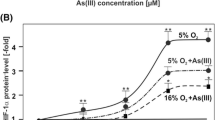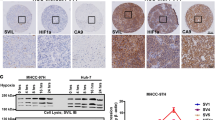Abstract
Hepatocyte growth factor activator inhibitor type 1 (HAI-1)/spint-1 is a membrane-bound protease inhibitor that is thought to regulate the activities of hepatocyte growth factor activator, matriptase, hepsin, and prostasin. In this study, we show that the membrane form of HAI-1 was significantly upregulated immunohistochemically in epithelial cells under adverse conditions including tissue injury, necroinflammatory reactions, and invasion of carcinomas. To analyze the mechanism underlying these in vivo observations, we examined the effects of hypoxia and oxidative stress on HAI-1 expression in vitro, using three human cell lines, HLC-1, WiDr, and HeLa. Hypoxic condition significantly enhanced the expression of HAI-1 in these cells. Oxidative stress also enhanced HAI-1 expression. Promoter analyses of the human HAI-1/spint-1 gene revealed overlapping binding site for Egr-1-3 and Sp1 near the transcription start site as the key domain for HAI-1/spint-1 transcription. This site was also critical in both hypoxic- and oxidative stress-induced HAI-1 upregulation. In fact, in vivo immunohistochemical studies indicated that areas with HAI-1 upregulation tended to express markers associated with hypoxia and oxidative stress. These observations suggest that the tissue microenvironment regulates the cell surface expression of HAI-1, and thereby may regulate proteolysis and processing of bioactive molecules on the cellular surface.







Similar content being viewed by others
References
Akiyama Y, Nagai M, Komaki W, Marutsuka K, Asada Y, Kataoka H (2006) Expression of hepatocyte growth factor activator inhibitor type 1 in endothelial cells. Hum Cell 19:91–97
Betsunoh H, Mukai S, Akiyama Y, Fukushima T, Minamiguchi N, Hasui Y, Osada Y, Kataoka H (2007) Clinical relevance of hepsin and hepatocyte growth factor activator inhibitor type 2 expression in renal cell carcinoma. Cancer Sci 98:491–498
Cai L, Johnstone BH, Cook TG, Liang Z, Traktuev D, Cornetta K, Ingram DA, Rosen ED, March KL (2007) Suppression of hepatocyte growth factor production impairs the ability of adipose-derived stem cells to promote ischemic tissue revascularization. Stem Cells 25:3234–3243
Christofori G (2006) New signals from the invasive front. Nature 441:444–450
Donaldson SH, Hirsh A, Li DC, Holloway G, Chao J, Boucher RC, Gabriel SE (2002) Regulation of the epithelial sodium channel by serine proteases in human airways. J Biol Chem 277:8338–8345
Fan B, Brennan J, Grant D, Peale F, Rangell L, Kirchhofer D (2007) Hepatocyte growth factor activator inhibitor-1 (HAI-1) is essential for the integrity of basement membranes in the developing placental labyrinth. Dev Biol 303:222–230
Generali D, Fox SB, Berruti A, Moore JW, Brizzi MP, Patel N, Allevi G, Bonardi S, Aguggini S, Bersiga A, Campo L, Dogliotti L, Bottini A, Harris AL (2007) Regulation of hepatocyte growth factor activator inhibitor 2 by hypoxia in breast cancer. Clin Cancer Res 13:550–558
Guo J, Chen S, Huang C, Chen L, Studholme DJ, Zhao S, Yu L (2004) MANSC: a seven-cysteine-containing domain present in animal membrane and extracellular proteins. Trends Biochem Sci 29:172–174
Itoh H, Yamauchi M, Kataoka H, Hamasuna R, Kitamura N, Koono M (2000) Genomic structure and chromosomal localization of the human hepatocyte growth factor activator inhibitor type 1 and 2 genes. Eur J Biochem 267:3351–3359
Itoh H, Kataoka H, Meng JY, Hamasuna R, Kitamura N, Koono M (2001) Mouse hepatocyte growth factor activator inhibitor type 1 (HAI-1) and type 2 (HAI-2)/placental bikunin genes and their promoters. Biochim Biophys Acta 1519:92–95
Kataoka H, Suganuma T, Shimomura T, Itoh H, Kitamura N, Nabeshima K, Koono M (1999) Distribution of hepatocyte growth factor activator inhibitor type 1 (HAI-1) in human tissues. Cellular surface localization of HAI-1 in simple columnar epithelium and its modulated expression in injured and regenerative tissues. J Histochem Cytochem 47:673–682
Kataoka H, Shimomura T, Kawaguchi T, Hamasuna R, Itoh H, Kitamura N, Miyazawa K, Koono M (2000) Hepatocyte growth factor activator inhibitor type 1 is a specific cell surface binding protein of hepatocyte growth factor activator (HGFA) and regulates HGFA activity in the pericellular microenvironment. J Biol Chem 275:40453–40462
Kataoka H, Itoh H, Nuki Y, Hamasuna R, Naganuma S, Kitamura N, Shimomura T (2002) Mouse hepatocyte growth factor (HGF) activator inhibitor type 2 lacking the first Kunitz domain potently inhibits the HGF activator. Biochem Biophys Res Commun 290:1096–1100
Kataoka H, Miyata S, Uchinokura S, Itoh H (2003) Roles of hepatocyte growth factor (HGF) activator and HGF activator inhibitor in the pericellular activation of HGF/scatter factor. Cancer Metastasis Rev 22:223–236
Kirchhofer D, Peek M, Lipari MT, Billeci K, Fan B, Moran P (2005) Hepsin activates pro-hepatocyte growth factor and is inhibited by hepatocyte growth factor activator inhibitor-1B (HAI-1B) and HAI-2. FEBS Lett 579:1945–1950
Lee MS, Kiyomiya K, Benaud C, Dickson RB, Lin CY (2005) Simultaneous activation and hepatocyte growth factor activator inhibitor 1-mediated inhibition of matriptase induced at activation foci in human mammary epithelial cells. Am J Physiol Cell Physiol 288:C932–941
Lee SL, Dickson RB, Lin CY (2000) Activation of hepatocyte growth factor and urokinase/plasminogen activator by matriptase, an epithelial membrane serine protease. J Biol Chem 275:36720–36725
Leyvraz C, Charles RP, Rubera I, Guitard M, Rotman S, Breiden B, Sandhoff K, Hummler E (2005) The epidermal barrier function is dependent on the serine protease CAP1/Prss8. J Cell Biol 170:487–496
Lin CY, Anders J, Johnson M, Dickson RB (1999) Purification and characterization of a complex containing matriptase and a Kunitz-type serine protease inhibitor from human milk. J Biol Chem 274:18237–18242
Moumen A, Patane S, Porras A, Dono R, Maina F (2007) Met acts on Mdm2 via mTOR to signal cell survival during development. Development 134:1443–1451
Mukai S, Fukushima T, Naka D, Tanaka H, Osada Y, Kataoka H (2008) Activation of hepatocyte growth factor activator zymogen (pro-HGFA) by human kallikrein 1-related peptidases. FEBS J 275:1003–1017
Nagaike K, Kohama K, Uchiyama S, Tanaka H, Chijiiwa K, Itoh H, Kataoka H (2004) Paradoxically enhanced immunoreactivity of hepatocyte growth factor activator inhibitor type 1 (HAI-1) in cancer cells at the invasion front. Cancer Sci 95:728–735
Nose K, Ohba M (1996) Functional activation of the egr-1 (early growth response-1) gene by hydrogen peroxide. Biochem J 316:381–383
Oberst MD, Chen LY, Kiyomiya K, Williams CA, Lee MS, Johnson MD, Dickson RB, Lin CY (2005) HAI-1 regulates activation and expression of matriptase, a membrane-bound serine protease. Am J Physiol Cell Physiol 289:C462–470
Salminen A, Liu PK, Hsu CY (1995) Alteration of transcription factor binding activities in the ischemic rat brain. Biochem Biophys Res Commun 212:939–944
Sasaki M, Ikeda H, Kataoka H, Nakanuma Y (2006) Augmented expression of hepatocytes growth factor activator inhibitor type 1 (HAI-1) in intrahepatic small bile ducts in primary biliary cirrhosis. Virchows Arch 449:462–471
Shimomura T, Denda K, Kitamura A, Kawaguchi T, Kito M, Kondo J, Kagaya S, Qin L, Takata H, Miyazawa K, Kitamura N (1997) Hepatocyte growth factor activator inhibitor, a novel Kunitz-type serine protease inhibitor. J Biol Chem 272:6370–6376
Sivridis E, Giatromanolaki A, Koukourakis MI (2005) Proliferating fibroblasts at the invading tumour edge of colorectal adenocarcinomas are associated with endogenous markers of hypoxia, acidity, and oxidative stress. J Clin Pathol 58:1033–1038
Sullivan R, Graham CH (2007) Hypoxia-driven selection of the metastatic phenotype. Cancer Metastasis Rev 26:319–331
Tanaka H, Nagaike K, Takeda N, Itoh H, Kohama K, Fukushima T, Miyata S, Uchiyama S, Uchinokura S, Shimomura T, Miyazawa K, Kitamura N, Yamada G, Kataoka H (2005) Hepatocyte growth factor activator inhibitor type 1 (HAI-1) is required for branching morphogenesis in the chorioallantoic placenta. Mol Cell Biol 25:5687–5698
Uhland K (2006) Matriptase and its putative role in cancer. Cell Mol Life Sci 63:2968–2978
Wu Q, Parry G (2007) Hepsin and prostate cancer. Front Biosci 12:5052–5059
Yan SF, Lu J, Zou YS et al (1999) Hypoxia-associated induction of early growth response-1 gene expression. J Biol Chem 274:15030–15040
Zhang P, Tchou-Wong KM, Costa M (2007) Egr-1 mediates hypoxia-inducible transcription of the NDRG1 gene through an overlapping Egr-1/Sp1 binding site in the promoter. Cancer Res 67:9125–913
Acknowledgments
This work was supported in part by grants-in-aid for scientific research (B) no. 17390116, 20390114 and the Miyazaki Prefecture Collaboration of Regional Entities for the Advancement of Technological Excellence, Japan Science and Technology Agency.
Conflict of interest statement
We declare that we have no conflict of interest.
Author information
Authors and Affiliations
Corresponding author
Rights and permissions
About this article
Cite this article
Komaki, W., Fukushima, T., Tanaka, H. et al. Expression of hepatocyte growth factor activator inhibitor type 1 on the epithelial cell surface is regulated by hypoxic and oxidative stresses. Virchows Arch 453, 347–357 (2008). https://doi.org/10.1007/s00428-008-0662-1
Received:
Revised:
Accepted:
Published:
Issue Date:
DOI: https://doi.org/10.1007/s00428-008-0662-1




